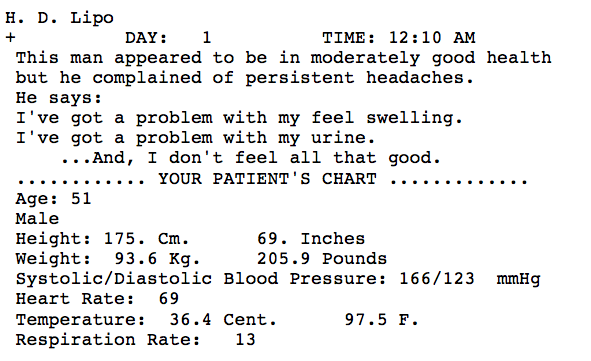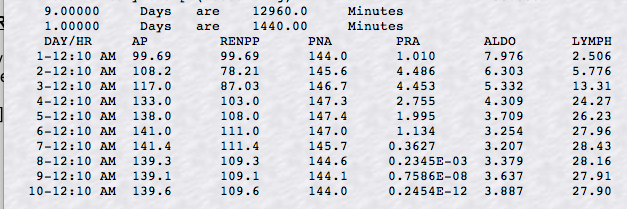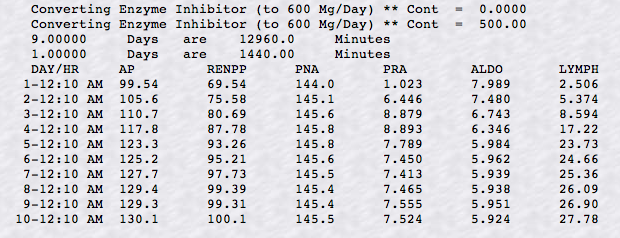Case
- Persistent headaches, feet swelling, "problem with my urine"
Hints
page 2
I. The Case (& preliminary "hints")
Case - Persistent headaches,
feet swelling, "problem with my urine".
II. The Chart
We again examine the information
revealed in HUMAN by selecting < Your
Patient's Chart > ...

We previously noted that several
of the vital
signs are in the abnormal range and that these include a
marked hypertension (166/123 mm Hg) and a high body weight (93.6 Kg).
The material below focuses largely
on the hypertension as opposed to the general renal aspects of the case
considered already on Hints page 1.
III.
Output data - Focusing on hypertension issues
As stated previously, this is
a somewhat complex case having at least two major components. The most
pressing of them, possible renal difficulties ["problem with my urine"],
was be the focus of hints page 1. Here we focus on the hypertension.
Part 1 - Establishing baseline case behavior
A] Setup:
The noting of hypertension
in the vital signs leads us to also focus on this issue.
To do so we choose output
variables and perhaps tests that
yield information targeted to possible renally-induced hypertension.
=> READ THIS! - In order to
observe the development of the hypertension and its possible underlying
causes I have taken the unusual tact of creating the patient (Lipo)
de novo from Mr. Norm L. Subject (see Analysis for how to do
this). E then follow this new Mr. Lipo for 9 days to observe the developing
hypertension.
A-1] Choosing output variables
to display
Variables: We change View
output: to
show a selection of renally-related hypertension variables, (see
below).

These are, left to right,
mean arterial pressure* (AP), renal perfusion pressure*, plasma sodium
(mEq/L), plasma renin activity (PRA, ng-AI/ml/hr), plasma aldosterone
(ng/dl) and lymph flow (ml/min).
*
AP is central aortic pressure and RENPP is the
pressure in a renal artery right before it begins to split into the segmental
renal arteries.
B] Results:
Having begun with Mr. Norm L. Subject and creating the pathology, we now
run for 9 days with 1 day between printouts to observe the development of
a snapshot of the current case.
B-1] Pattern
of the physiological variables

Some items in the above data
to think upon here include
• why might plasma Na first
rise then fall?
• why might plasma renin activity
first rise then fall?
• what could be the cause
of a difference between AP and RENPP?
Part 2 - Blocking the renin-angiotensin
system
A] Setup:
Anyone reaching this point in
this (or any) case should have solid basic familiarity with the renin-angiotensin-aldosterone
blood volume control system.
Below we run the identical 9 day
experiment as above but with the system largely blocked at the converting
enzyme step employing CEI [converting enzyme inhibitor] (i.e. an ACE inhibitor,
an angiotensin-converting enzyme inhibitor).

B] Results:
Compare this pattern with the pattern in Part 1 above with no CEI present

Some items in the above data
to think upon include
• How does the pattern of
plasma renin activity (PRA) differ in the presence of the ACE inhibitor?
• What effect does this change
have on the pattern of PNA? 2) RENPP? 3) mean central AP
• What might be causing the
difference between AP and RENP
IV. More
This ends the second hints section
on this case.
You should attempt again at this point to arrive at a diagnosis and a treatment. To do so
• Return to the HUMAN model's
Physiology Lab section for this patient and verify
- the diagnosis by finding the appropriate variables to support your argument and
- the treatment by changing parameters so as to stabilize the patient.
VI. Analysis
If you wish further analysis and a diagnosis on
this case and information on how it was created, click on this link ( analysis ) and log in as requested.
* Note: Case hints and analyses are based heavily on Drs. Randall and Coleman's HUMAN-80 Instructor's Manual supplemented by notes of Dr. Coleman's in the model code itself and findings by myself and other colleagues over our years of use of these cases.




